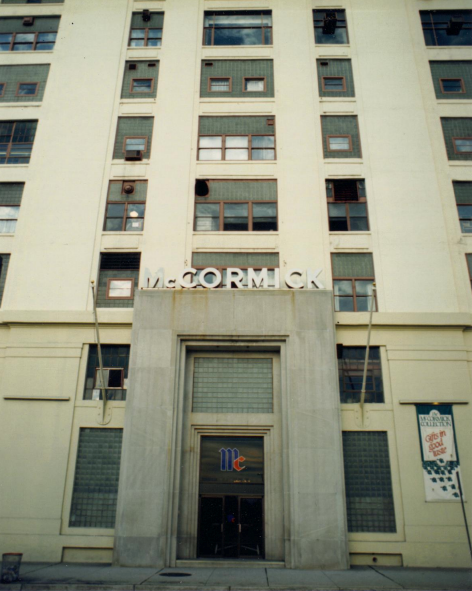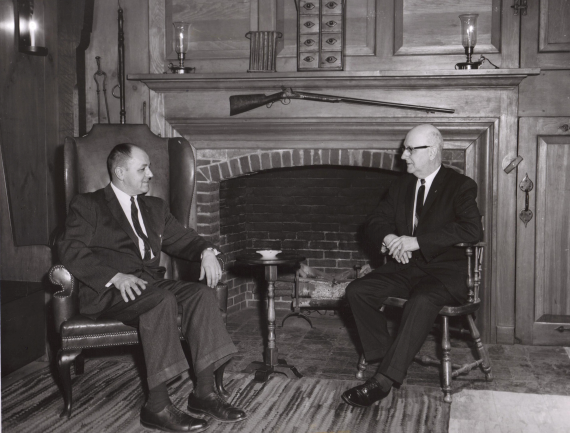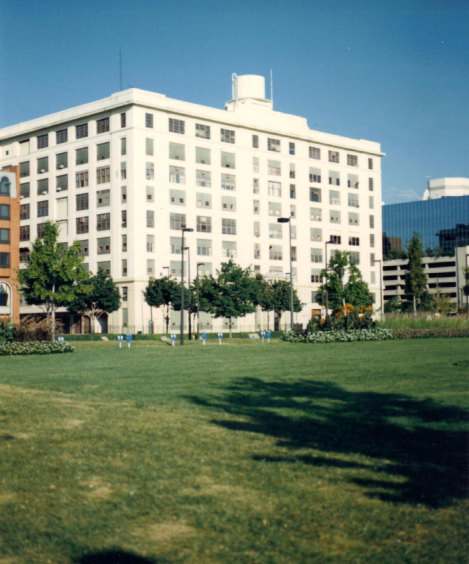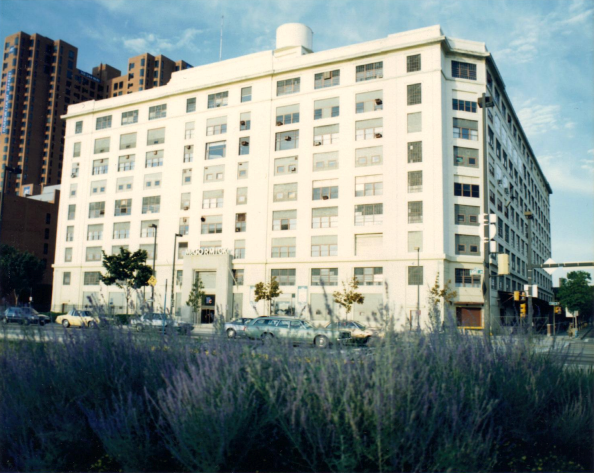The two part article that follows was published in The News American (a Baltimore newspaper that no longer exists) on April 30th and May 1st 1964. This article is unique in that it takes the reader on a floor by floor tour of the Light Street Plant, and mentions by name a great many of the people who worked there at that time. It is truly a “walk down memory lane.”
The News American – April 30, 1964
Inside McCormick & Co.
All the World Smacks Its Lips over its Spicy Products
by Tony Evans
What goes on in the sweetest smelling building in Baltimore?
That’s the McCormick and Company plant on Light St. which overlooks the inner harbor. And like Fort McHenry, most Baltimoreans haven’t been inside and don’t know too much about the complex and romantic operations of “McCormick’s.”
McCormick and Co. may be just as well known in the world as Johns Hopkins Hospital. Its spices may be found on tables and in kitchens all over the county and in mountain climbers’ packs atop Mt. Everest. There’s an international “air” about McCormick’s which is in keeping with the harbor it overlooks. Clipper ships used to bring to Baltimore tea from China, vanilla beans from Zanzibar, anise from Spain, basil from Persia, caraway from Holland, cinnamon from Indo-China, ginger from the West Indies, nutmeg from the East Indies, and paprika from Morocco. Today ships still come to Baltimore bearing those spices – and many more too. The names of some of the countries have changed and today most of our tea comes from India and Ceylon.
McCormick and Co. – the reason for the spices coming to Baltimore – has changed a lot too. It’s grown bigger, figured out better quality control, better packaging, and many more products involving spices. It’s also figured out how to keep its workers happy and interested in their jobs.
Let’s take a look at some of the basic workings of a spice house and some of the people involved at McCormick’s.
The production of spices at McCormick’s is handled by C. H. (Jack) Keller and the distribution of them is handled by J. L. (Jim) Grem. Let’s see how Keller’s workers process, prepare and package spices. Starting on the building’s ninth floor Merle Shockey has a printing department. Charles Brown and Oscar Evans are on his crew that prints up many of the labels and cartons used by McCormick. Grem has part of the ninth floor as part of his department’s warehouse system.
Down on the eighth floor spice milling manager Larry Curtis has his start of the mustard seed-flour operation. Most of the floor is used for the storage of raw materials.
The seventh floor is given over to spice materials storage and spice milling. Curtis has Joe Smith handling spice cleaning here. Also on the seventh floor are executive offices, the famed “Friendship Court” and “McCormick Tea House,” “Crow’s Nest” inner sanctum and the office of Charles P. McCormick.
On the sixth floor you have a continuation of spice milling. Curtis has Melvin Meyers and Grover Metz helping him keep his milling machines and operators going. Vanilla is extracted here in a department run by Gil Barton who also handles the tea blending department which is located here. John Engelmen helps to keep the kettles boiling out vanilla extract. Another man on the floor is Martin Schnuit.
Bill Kramer is a tea blender and works by the formulas set down by tea tester and buyer Bill Hall. He may be working with as many as 18 different teas. Mustard sifting is done here too. The chief mustard miller is John Vance, while the chief miller for pepper, cinnamon and other milled spices is August Mayne. Most of the milling is done on the fifth floor. Elmer Cullison is the man to mix the mustard flour and Ed Schwartz handles spice blend mixing.
There’s the foil package filling operation here, involving things such as cheese dip, sauce, meat loaf seasoning and others. There’s a drug filling department here, too. McCormick does a lot of work in packaging non-prescription items such as epsom salts, turpentine and ammonia for sale by independent stores. Al Metzger runs the filling operations on this floor. He is assisted by Dan Reed. Keeping the machines running for operators Anna Radomski and Arthur Mentzell is mechanic Calvin Ludwig.
On the fourth floor is the cafeteria which is run for McCormick by Bob Hargraves with help from Marie Kenney and Florence Beckhardt. Behind the cafeteria there is the final spice milling and the in-process storage area for prepared spices which are kept in hoppers and bins for gravity flow to the main filling area below. Ken Wolf runs things here, keeping materials handlers Elmer Dennis, Howard Artis, Earl Folks, Charles Busick and Garland Bevins busy.
There’s an area on the floor for bulk spice filling involving big cans and drums running up to 200 pound capacity. William Horne and John Geisler work at doing this. Nathan Street works in a smaller area involved with making up salad dressings.
On the third floor McCormick has its extract filling, spice filling and tea filling operations. Harry Snyder runs the tea and extract filling department. Putting extract into bottles with machines that vacuum fill, cap, label, carton and “overwarp” are Bernice Vinch, Wanda Drawer, Thelma Cook and Norma Muscalli. Gus Lavenroth and Bob Noll are mechanics who keep the extract-filling machines in tip-top shape.
In the tea-filling section floor lady Florence Stolarski helps Snyder’s crew, including operators and packers Evelyn Maker and Isabelle Auer. The tea is put into bags by a machine that forms a funnel of paper out of roll stock, makes up the bags that are folded, side filled, sealed and given their “dunking string and tag” before being packed into various-sized cartons. John Burdinski and O.Q. Wilkinson are mechanics who adjust and maintain the tea-filling equipment.
In the spice filling area Ron Numbers guides things. He has his people, including Marie Wiggman, Ann Geppi and Margaret Kahl – a 42-year veteran with McCormick, busy running can and bottle lines, hand packing and making up larger size bulk and institutional packages. Lou Heil and Tom Tarbart are the mechanics in this section. Material handlers who keep things flowing are Milton Frech, John Kitko and Joseph Collins who’s working there until his college studies resume.
In the condiment filling section Milford Melling acts as work leader. Two of his people are Hilda Phoebus and Elizabeth Lang.
Down on the second floor is where Jim Grem’s real work begins to show. That’s the stockroom. Supervisor here is Emory Luers who is aided by Harry Presti and Arthur Kirk. Putting the heft in getting things moved around by the thousands of cartons each day are Bill Stumbo and Mike Bolewicki. A special export section is run by Percy Jewell.
On the first floor are the shipping and receiving department and the maintenance shop. Running things in shipping are Carl Schlaich for traffic and John Dixon for shipping. The entire McCormick division’s traffic problems are masterminded by George Roth who has a battery of three girls: Bertha Blake, Bernie janoski and Gertrude Fegelein in his office. Putting the heft to things in shipping are Russell Frank and Gene McCormick, who oddly enough, is not related to the other McCormicks at McCormick and Co.
About 30 percent of the Baltimore plant’s production is shipped out in weekly large-sized lots to the company’s Memphis warehouse. Key people in the receiving section are supervisor Rex Walsh, Ed Riley and Al Disney – who is the rail and truck specialist. Curt Johnson and Bob Bush put the heft in on the receiving section. There’s also a sample department which is a catch-all group that sends out sales promotion packages, small lots for salesmen and prospective buyers. This group includes Don Silbaugh, John Gerlach and Ed Shuppel.
Handling maintenance for plant superintendent Gil Adelhardt is supervisor John McCue. His crew includes pipefitter R. C. Pennington, electrical work leader W. E. Engelbach, estimator James Cavey, painter C. C. Flandorfer, millwright Ed Henry, carpenter Bob Sefton and L. P. Buckingham.
Some of the other key people in the McCormick plant’s operations are Mary Heckwolf who is the only woman plant supervisor who handles material, J. F. Butt who is in charge of special plant operations, Tom Miller who buys non-spice raw materials, Harvey Weeks who buys packaging materials and Stan Godwin who buys supplies and equipment.
Then there’s machine mechanics supervisor G. R. Patnode and his central maintenance crew including Ray Willey, Edwin Stackpole and Hammond Dugent. A spice plant has to be clean and its kept that way by building services supervisor F. P. Thurston and Charles Woods, George Howard, Carroll Lawson and Esther Robinson.
Then there’s Bernard Lyons who runs the “gas Chamber” up on the roof. Some spices are given a gassing so that insects won’t take a liking to them later.


Receptionist, Pete Makar (left), speaking to Bernard McGuire in the lobby of
414 Light Street
Part 2
The News American – May 1, 1964
McCormick & Co.
“House of Flavor” Proves It’s People That Make It Work
by Tony Evans
“The House of Flavor,” that’s what McCormick & Co. here in Baltimore uses as an advertising slogan. A look inside the McCormick operations reveals that when it comes to making the company work, that flavor comes from people.
The people are the ones that make McCormick & Co. work. And work it does.
The company was started here in 1889 as a spice and flavoring extract business by Willoughby M. McCormick who had it doing about $3½ million worth of business by 1928. In 1963 net sales hit $55 million plus.
When you think of McCormick people you just can’t start anywhere but with Charles P. McCormick himself who is Chairman of the Board. “Charlie” or “CP” as he’s known to his workers and friends is quite a man. He coined the phrase “human relations” and even puts it on his company’s balance sheet as an asset, he leaves his office door open all the time, has a record of service on city, state, federal and international commissions and delegations, pioneered “multiple management” which still is a “new” concept in the business world and once convinced a union organizer – during a cigar smoking times debate – that he was able to do more for his employees than a union.
He’s also been fired from the company about six times and rehired seven. But that was back in the old days.
Charlie was 36 in 1932 when his uncle died and he was elected president of the company. He had a mental spice chest full of ideas and the fact that the company was losing money, cutting wages and losing business in the depression didn’t faze him one bit. It helped. He raised wages, cut working hours, made people want to do their jobs and made them feel wanted. What happened? Three months later the company was in the black and Charley hiked wages again.
He believed in holding meetings with all the workers present, telling them what was going on and letting them look at the books. He still does.
He set up multiple management in which the senior board of directors has counterparts in the junior board, the factory board and the sales board. These boards are made up of men who actually work in these departments. They mull ideas, get answers, approve plans and send them up to the senior board. Their batting average of accepted ideas is over .900.
Another thing Charlie did was to build the quaint “Ye Olde McCormick Tea House” which along with Friendship Court on the seventh floor is done in 18th Century English décor. Why? Charlie, having been a “peddler” for years thought salesmen should be treated better when they call. He instituted profit sharing with his workers. This has plowed millions of dollars back to McCormick & Co. workers. Another idea that started with McCormick is “CDay” in the fall. Everyone from Charlie on down voluntarily works on a Saturday and puts in a full day. The time-and-a-half pay earned by the employees goes to the Community Chest-Red Cross-United Appeal and is matched dollar for dollar by the company.
Keeping up with a man like this just isn’t easy as President John N. Curlett, executive vice president James Welsh, VP for public relations Ed Vinnicombe Jr., human relations VP K. Brantley Watson, manufacturing VP C. Douglas Reed and even his own son, “Buzz” who is assistant to General Manager Welsh, will tell you. They work pretty hard at it though.
Curlett, who started with McCormick in 1930 and was one of Charlie’s first band of young Turks, is active in banking, the Maryland Historical Society, the Baltimore Association of Commerce, Red Shield Boys’ Clubs and the advisory commission for Church Home and Hospital. John served as chairman of the Curlett Commission which formulated the recently enacted legislation calling for major expansion and reorganization of higher education in Maryland.
Vinnicombe is active in four hotel and restaurant association, the Tidewater Fisheries Commission’s boating advisory committee.
C. P. Jr., (Buzz), is a boating and sports ‘nut” who is active in four boating groups, the Merchants Club and the Association of Commerce.
The McCormick “People Flavor” begins as you walk in the front door. Pete Makar, a receptionist greets you on your way upstairs in real people-operated elevators. Geraldine Jenkins, George Hampton and Jean Resuta start talking to you. Then hostesses Joanne Creamer, Anne Kemp, Daphine Erich and Chris Moore greet you on the seventh floor, guide you to the person you are to see, or if you have to wait they’ll take you into the tea house or the plush “junior lounge” get you a book or magazine or show you how to work a double periscope so you can watch things out in the harbor. They are attired in specially made Elizabethan dresses complete with hoops and plenty of smiles. They admit “it takes some getting used to” before they mastered the hoop skirts. They also escort tours through the plant.
You might peek into the experimental kitchen where home economist Helen Carlisle and Polly Murray and LaRae smith are busy cooking up new dishes, recipes, cook books, label information and ways to beguile food editors.
Or you might see tea taster Bill Hall sitting at his lazy Susan table tasting teas and chatting with his secretary, Steuart Gantt. Hall, a Canadian who learned the tea business in England, samples anywhere from 60-100 cups of tea a day. Hall can tell you of the thousands of teas, how he blends McCormick’s using 15-20 different teas in a one ton-batch, that the thing wrong with most tea making is that it’s not allowed to “brew” long enough and that most restaurants in his opinion – 28 years in the tea business worth – “don’t make a good cup of tea.” He also says the brewing time is about six minutes, that tea consumption in this country has gone up 19 percent since 1951, and that the Orioles welcomed tea on the training table diet because “there’s more staying power in tea.” His pet peeve is the notion that tea is a “sissy drink.” Miss Gantt, who helps Hall spend millions of dollars on teas each year, can tell you what’s with the Orioles and with sportswriters.
A peek through another open door might reveal public relations director Paul Welsh at work preparing spice maps, arranging press releases.
The man who buys McCormick’s spices from all over the world is Charley Staylor who has his work area facing the harbor so he can watch the spice ships come in.
Jack Silber has the job of translating sales forecasts into production schedules. Tom Mullinix is manager for filling and special manufacturing. Planning and scheduling is done in the plant by Eugene Colleran.
Bob Crampton handles the market research operations, is the son of another McCormick Corporate big gun: R. C. Crampton, who heads the Schilling Division on the West Coast.
Sales Director is Dave Michels who masterminds a team of several hundred men out in the field. McCormick’s buying on the division level is taken care of by John Doub while Howard Wolf handles things on a corporate level.
Walter Andrews makes sure people get paid while the office services department is run by M. Loretta Gadsby.
Human relations on the division level are taken care of by Fred Ogburn assisted by Roy Lorenz.
Bob Bradshaw manages the specifications department. Sales promotion and advertising is Charles Mattern’s bailiwick. Garland Feelemeyer runs the inspection services department that makes sure full measure is going into each container. He’s helped by Barney Lubertine, Elizabeth Jewell and Louise King.
Plant engineering is done by Wes Shapro with industrial engineer Bill Flagg. “Secretarial engineering” – the art of keeping the boss going, is done by many women. Two crackerjacks at this are Eileen Keough and Agnes Edwards.
Quality Control – next to the smell of spices, the enthusiasm of Charlie McCormick and “human relations” – is the thing you hear most about these days at McCormick’s. It is run by Walter Kuhl. Supervisor of his lab is Phil Guarino.
In Research and Development under Richard Hall you have Bill Stahl, food technologist Albert Karas and senior research chemist Jim Sullivan. Sullivan keeps a “smell library” which is unique. The library contains hundreds of bottles that contain in turn just about every odor you can imagine – and some you can’t.
But the secret of “smell” at McCormick’s – you can smell it as you drive by outside – probably is best answered by Henry Ollie. It comes from the thousands of cinnamon quills he feeds to an automatic cutting machine.


These two photographs of 414 Light Street were taken just before the building was torn down.
Last update: 12/23/2009
